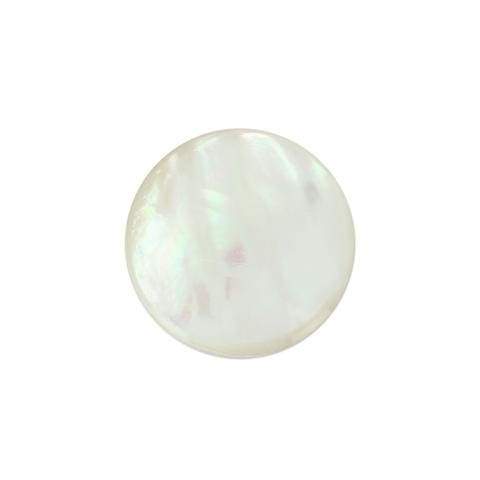Nacre
Properties of mother-of-pearl
Mother-of-pearl is a mineral biosynthesized by certain mollusk species to line the inside of their shells. It is composed primarily of aragonite microcrystals, which alone make up about 85% of its composition. The remaining 3% consists of a protein called conchyolin (13%), which acts as a binder for the aragonite crystals, and water.
The color of mother-of-pearl is not actually due to a single pigment, but rather to the superposition of layers of materials whose refractive index varies from one layer to the next. As a result, the color is determined by the observer's position and the angle at which light strikes the mother-of-pearl's surface. Some varieties of mother-of-pearl may have yellow or purple reflections; this is primarily due to the presence of certain pigments in the conchyolin proteins. Mother-of-pearl has a density of 2.95, and its hardness ranges from 3.5 to 4 on the Mohs scale.
The most precious and prized mother-of-pearl, known as "free mother-of-pearl", is found in the seas and territorial waters of Australia, the Philippines, Indonesia, the coasts of some African countries such as Djibouti and Madagascar, and on the western coasts of India and in the Arabian Sea.

History of mother-of-pearl
Etymologically, the term mother-of-pearl comes from the Arabic word "naqqarah." This material has been, and continues to be, the object of particular fascination due to its beauty and refinement. Several great civilizations have known and used mother-of-pearl for various purposes, including the manufacture of tools, containers, or jewelry, or even dental implants, as the Maya did.
From China to ancient Rome, passing through Persia, Mesopotamia, Egypt, Greece, the great cultures of the ancient world have used and appreciated mother-of-pearl, which in some cases was used as currency.
Discover all our mineral bracelets

From the Middle Ages onward, mother-of-pearl acquired religious symbolism among Christians and was often associated with the Virgin Mary because of its whiteness and purity. Some large shells were even used as baptismal fonts or were considered religious symbols, such as the scallop shell, which symbolized the pilgrimage to Santiago de Compostela.
Today, mother-of-pearl has many uses. From jewelry and woodworking to the creation of fashion accessories, humankind has created countless wonders of craftsmanship using this noble and unique material.
Benefits of mother-of-pearl
Mother-of-pearl is now the subject of extensive medical studies for its ability to regenerate bone and its potential use in reconstructive surgery. Lithotherapy also recognizes several virtues of mother-of-pearl, which are said to be beneficial for protecting and stimulating the entire digestive system. It is also indicated for combating the flu, fever, eye diseases, and calcium deficiencies.
Emotionally and spiritually, mother-of-pearl acts as a calming element. It is said to dispel mood swings, anger, anxiety, and all excessive emotional states that can affect daily life.
Discover all our mineral bracelets

A stone of intuition and open-mindedness, it purifies the aura and facilitates access to the astral body. Mother-of-pearl promotes the circulation of energies in the body and allows the mind to concentrate, facilitating access to wisdom. It is also particularly beneficial for the solar plexus and third eye chakras.
The astrological signs of mother-of-pearl are Cancer, Virgo, Gemini, Capricorn, and Pisces.
To purify mother-of-pearl, simply soak it in distilled water with salt. To recharge it, sunlight or moonlight should quickly restore its full potency and benefits.

















